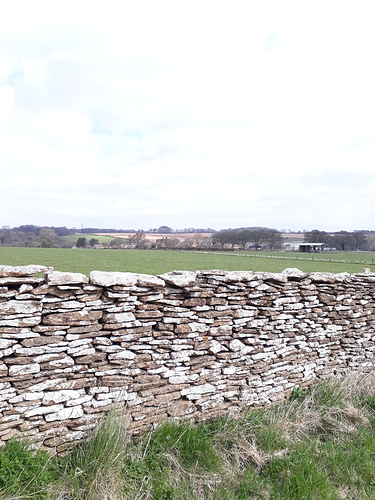Exactly!
Cotswold stone. Such a classic that local government grants are available to maintain them. Deer knock them over, some winter weather can make parts collapse, people climbing and foxhunts jumping them can cause collapse but dry stone walls can last for centuries.
The previous owners of our property, which we bought last fall, let a very thorny, invasive vine grow all over the fences. It certainly was effective in providing a barrier no horse would want to go through and tall enough that they wouldn’t go over. I believe it is called multiflora rose and is now banned in Massachusetts.
We are in the process of ripping it all out and replacing with 4 rail post and rail fence. It is nasty stuff. Even with leather, elbow length rose pruning gloves on, the thorns have gotten me multiple times. It also causes an allergic reaction that is vaguely poison ivy-like with enough contact.
I wonder if goats could eat that down for you?
Mine would ! We have some here and they stripped it clean. Although some came back this Spring and they will get another chance at what is left. Usually after the second year they have access to it most brush does not come back.
Ugh, I feel for you. We have a lot of different types of pokey garbage plants here, and the rose is THE WORST. It’s just awful to work around. 
According to the webz " Goats are likely the best biological method of control for multiflora rose . About 80% of a goat’s diet can come from browse and goats are often happy to eat multiflora rose . Adding some goats to your pasture can help remove woody plants. The challenge with goats is the ability to keep them in the desired fenced area." 
Here in the wet PNW, metal T posts and wire are the most common fence types. On the east side, stacked stone in wire cages with barbed wire is sometimes used where you can’t pound a post into the incredibly rocky soil. My dad built some rock posts on our small acreage in the rocky outcrop areas, along with some dry stone walls to bridge some dips in the fence line. He was from Wisconsin and had built something similar there he said.
We are using blackberries, wild filbert, plum, and other native shrubs as a hedge (with a wire field fence inside it) along our western fence line. It keeps the neighbor’s cattle off our fence, provides a wind block, and wildlife habitat. There’s even a “coyote hole” in it where larger animals cross through the fence—we actually cut the bottom off the wire to create the pass through. My favorite animal to spot is the bobcat! So handsome!
That’s my issue! Our neighbors actually have a small herd of mini goats and I’m pretty sure they would let us borrow them. But I don’t have an easy way to keep them contained.
One option would be electric net fencing? A little spendy initially, but sells well on the used market!
Our Icelandic sheep go for these horrid invasive things in a big way! The ones that try to get a start in our pastures never reach size. The problem with sheep and those things is fleece. A sheep can get bound in them …so you need to keep a daily watch. I am moving my sheep into a close pasture for the month of May, the end of which they get sheared. And that will keep them carefree with multiflora thru til next winter.
Electro-net fencing…i have TONS of this stuff. I’ll sell you some cheap!


